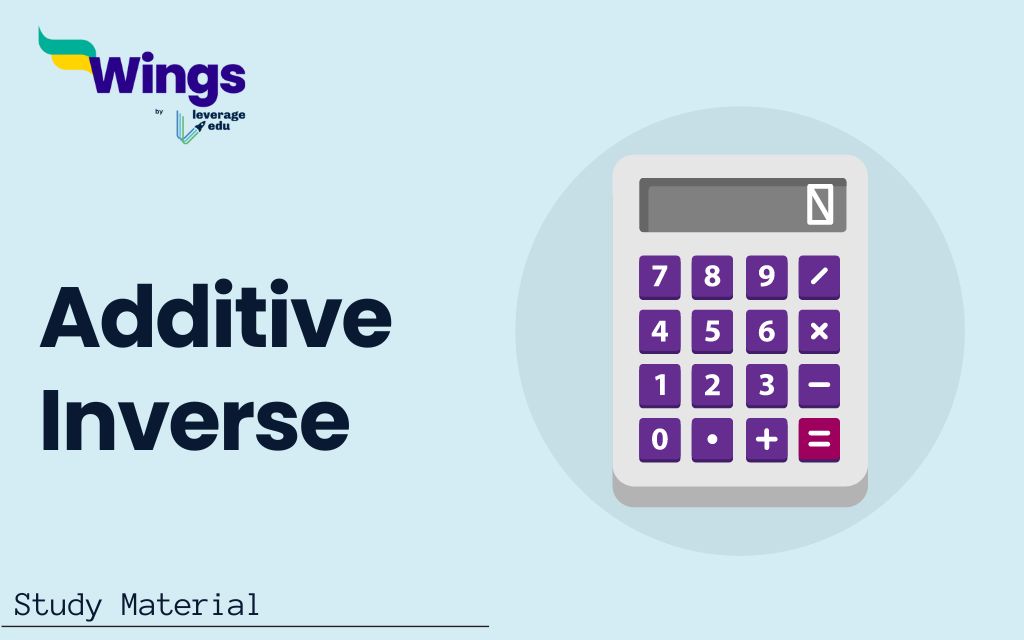The additive inverse is a fundamental concept in mathematics, particularly in algebra and number theory. It refers to a number that, when added to a given number, results in zero. This concept is important for solving equations and understanding the structure of various mathematical systems. In this blog, we will understand the definition of the additive inverse, explore its essential properties, and important formulas, and work through solved examples to solve its practical applications.
Contents
Definition of Additive Inverse
The additive inverse of a number is a value that, when added to the original number, results in zero. This concept is essential in various branches of mathematics, particularly in algebra, where it plays a key role in solving equations and understanding numerical structures.
For any given number aaa, its additive inverse is −a. Mathematically, this can be expressed as:
| a+(−a) = 0 |
- Existence: Every real number has an additive inverse. For any number a, there exists a number −a such that:
| a+(−a) = 0 |
- Uniqueness: The additive inverse of a number is unique. For any number a, there is only one number −a that satisfies the equation:
| a+(−a) = 0 |
- Additive Inverse of Zero: The additive inverse of zero is zero itself:
| 0+0 = 0 |
- Double Inverse: The additive inverse of the additive inverse of a number is the number itself:
| −(−a) = a |
- Inverse of a Sum: The additive inverse of the sum of two numbers is equal to the sum of their additive inverses:
| −(a+b) = −a + (−b) |
- Distributive Property: The additive inverse distributes over addition:
| −(a+b) = −a −b |
Also Read: Division of Algebraic Expressions
Properties of Additive Inverse
The additive inverse of a number is an important concept in mathematics, particularly in algebra. Here, we explore the properties of additive inverses along with examples to illustrate each property.
- Existence of Additive Inverse:
- For every real number aaa, there exists an additive inverse −a such that a+(−a) = 0.
- Example: For a=5, the additive inverse is −5, since 5+(−5)=0.
- Uniqueness:
- The additive inverse of a number is unique. For any number aaa, there is only one number −a that satisfies a+(−a) = 0.
- Example: For a=−7, the additive inverse is 7, and there is no other number that will satisfy −7+x = 0 except x=7.
- Additive Inverse of Zero:
- The additive inverse of zero is zero itself: 0+0 = 0.
- Example: 0 has an additive inverse of 0, since 0+0 = 0.
- Double Inverse:
- The additive inverse of the additive inverse of a number is the number itself: −(−a) = a.
- Example: If a = 3, the additive inverse is −3. The additive inverse of −3 is 3, so −(−3) = 3.
- Inverse of a Sum:
- The additive inverse of the sum of two numbers is equal to the sum of their additive inverses: −(a+b) = −a+(−b).
- Example: For a=4 and b=−6, the additive inverse of 4+(−6)=−2 is 2. This is the same as −4+6 = 2.
- Distributive Property:
- The additive inverse distributes over addition: −(a+b) = −a−b.
- Example: For a=2 and b=5, −(2+5)=−7. Distributing the additive inverse gives −2−5 = −7.
- Additive Inverse in Subtraction:
- Subtraction can be interpreted using additive inverses: a−b = a+(−b).
- Example: For a=8 and b=3, 8−3=8+(−3) = 5.
Additive Inverse Solved Examples
Here are five solved examples to illustrate the concept of the additive inverse:
Example 1: Finding the Additive Inverse of a Positive Number
Problem: What is the additive inverse of 7?
Solution:
The additive inverse of 7 is −7 because: 7+(−7) = 0
Example 2: Finding the Additive Inverse of a Negative Number
Problem: What is the additive inverse of −12?
Solution:
The additive inverse of −12 is 12 because: −12+12 = 0
Example 3: Using the Additive Inverse in an Equation
Problem: Solve the equation x+9 = 0.
Solution:
To solve for x, we need to find the additive inverse of 9, which is −9: x=−9 Check: −9+9 = 0
Example 4: Additive Inverse of a Fraction
Problem: What is the additive inverse of 5/8?
Solution:
The additive inverse of 5/8 is −5/8 because: 5/8+(−5/8) = 0
Example 5: Applying the Additive Inverse to Solve a Real-World Problem
Problem: If the temperature is 15∘C and it drops by 15∘C, what is the final temperature?
Solution:
The temperature drop is the additive inverse of 15∘C, which is −15∘C. Therefore, the final temperature is: 15∘C+(−15∘C) = 0
Also Read: Reciprocal: Definition, Meaning, Properties, and Solved Examples
FAQs
The additive inverse of -7 is 7. When added together, -7 and 7 equal 0.
The additive inverse of 12 is -12. When added together, they equal zero.
The additive inverse of 11/-15 is 15/11. When added together, they equal zero.
This was all about “Additive Inverse”. For more such informative blogs, check out our Study Material Section, or you can learn more about us by visiting our Indian exams page.
 One app for all your study abroad needs
One app for all your study abroad needs














